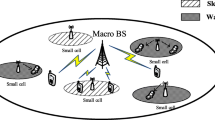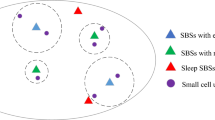Abstract
In this paper, the resource scheduling and power control strategy is studied for a two-tier 5G network system, which is comprised of a central macrocell and several small cells. Because cellular deployment is ultra dense in the 5G network, a sleep strategy for small cells is proposed to reduce energy consumption caused by the cellular overlapping coverage. Specifically, the imperfect channel state information (CSI) is considered due to the complex and dynamic communication environment in practice. This work attempts to maximize the resource utilization and enhance the robustness of the power control strategy with imperfect CSI. An optimization problem with probability constraints is formulated, and the high rate requirements of 5G network users are included. A novel method is provided to convert probability constraints into deterministic ones. An iterative algorithm of power control to enhance the network efficiency is proposed further. Finally, numerical results are given to illustrate the effectiveness of the joint resource scheduling scheme.








Similar content being viewed by others
References
Gupta, A., & Jha, R. K. (2015). A survey of 5G network: Architecture and emerging technologies. IEEE Access, 3, 1206–1232.
Qamar, F., Hindia, N., Dimyati, K., Noordin, K. A., & Amiri, I. S. (2019). Interference management issues for the future 5G network: A review. Telecommunication Systems, 71(4), 627–643.
Alsheyab, H. Y., Choudhury, S., & Bedeer, E. (2019). Near-optimal resource allocation algorithms for 5G+ cellular networks. IEEE Transactions on Vehicular Technolgy, 68(7), 6578–6592.
Liu, Y., Wang, H., Peng, M., Guan, J., Xu, J., & Wang, Y. (2020). DeePGA: A privacy-preserving data aggregation game in crowdsensing via deep reinforcement learning. IEEE Internet of Things Journal, 7(5), 4113–4127.
Ashraf, I., Boccardi, F., & Ho, L. (2011). Sleep mode techniques for small cell deployments. IEEE Communications Magazine, 49(8), 72–79.
Soh, Y. S., Quek, T. Q. S., & Kountouris, M. (2013). Dynamic sleep mode strategies in energy efficient cellular networks. In IEEE international conference on communications (pp. 3131–3136).
Bouras, C., & Diles, G. (2017). Distributed sleep mode power control in 5G ultra dense networks. In International conference on wired/wireless internet communication (pp. 65–76).
Liu, C., Natarajan, B., & Xia, H. (2016). Small cell base station sleep strategies for energy efficiency. IEEE Transactions on Vehicular Technology, 65(3), 1652–1661.
Samarakoon, S., Bennis, M., & Saad, W. (2019). Energy-efficient sleep strategy with variant sleep depths for open-access femtocell networks. IEEE Communications Letters, 23(4), 780–711.
Sun, Y., & Chang, Y. (2018). Energy-efficient user association and cell sleeping strategy for multi-tier ultra-dense small cell networks. Electronic Letters, 54(12), 787–788.
Wildemeersch, M., Quek, T. Q. S., & Slump, C. H. (2013). Cognitive small cell networks: Energy efficiency and trade-offs. IEEE Transactions on Communications, 61(9), 4016–4029.
Zhang, W., Mallik, R., & Letaief, K. (2009). Optimization of cooperative spectrum sensing with energy detection in cognitive radio networks. IEEE Transactions on Wireless Communications, 8(12), 5761–5766.
Liu, Y., Peng, M., Jiang, Z., Xu, Z., Guan, J., & Yao, S. (2020). COMP: Online control mechanism for profit maximization in privacy-preserving crowdsensing. IEEE Journal on Selected Areas in Communication, 38(7), 1614–1628.
Xiong, Z., Krishna, R., Cumanan, K., & Lambotharan, S. (2011). Grassmannian beamforming and null space broadcasting protocols for cognitive radio networks. IET Signal Processing, 5(5), 451–460.
Han, Q., Ma, K., Liu, Z., & Guan, X. (2013). Power control based on maximum power adaption in two-tier Femtocell networks. Wireless Personal Communications, 70(1), 331–351.
Kim, M. S., Je, H., & Tobagi, F. A. (2010). Cross-tier interference mitigation for two-tier OFDMA femtocell networks with limited macrocell information. In IEEE global telecommunications conference (pp. 1–5).
Liu, Z., Gao, L., Liu, Y., Guan, X., Ma, K., & Wang, Y. (2019). Efficient QoS support for robust resource allocation in blockchain-based Femtocell networks. IEEE Transactions on Industrial Informatics, 16(11), 7070–7080.
Liu, Z., Yuan, Y., Yuan, H., & Guan, X. (2019). Allocation based on proportional-integral controller in femtocell networks with consideration of maximum power constraint. IEEE Systems Journal, 13(1), 88–97.
Thakur, R., Swain, S. N., Murthy, C. S. R., & Siva Ram, C. (2018). An energy efficient cell selection framework for femtocell networks with limited backhaul link capacity. IEEE Systems Journal, 12(2), 1969–1980.
LeAnh, T., Tran, N. H., Saad, W., & Walid, (2017). Matching theory for distributed user association and resource allocation in cognitive femtocell networks. IEEE Transactions on Vehicular Technolgy, 66(9), 8413–8428.
Ngo, D. T., Le, L. B., & Le-Ngoc, T. (2012). Distribuated Pareto-optimal power control for utility maximization in femtocell networks. IEEE Transactions on Wireless Communications, 11(10), 3434–3446.
Liu, Z., Wang, S., Liu, Y., & Wang, Y. (2018). Secrecy transmission for Femtocell networks against external eavesdropper. IEEE Transactions on Wireless Communications, 17(8), 5016–5028.
Liu, Z., Li, S., Ma, K., Guan, X., & Li, X. (2017). Robust power allocation based on hierarchical game with consideration of different user requirements in two-tier femtocell networks. Computer Networks, 122, 179–190.
Kim, D. I., Le, L. B., & Hossain, E. (2008). Joint rate and power allocation for cognitive radios in dynamic spectrum access environment. IEEE Transactions on Wireless Communications, 7(12), 5517–5527.
Papandriopoulos, J., & Evans, J. S. (2006). Low-complexity distributed algorithms for spectrum balancing in multi-user DSL networks. IEEE International Conference on Communications, 7, 3270–3275.
Liu, Z., Hou, G., Yuan, Y., Chan, K. Y., Ma, K., & Guan, X. (2020). Robust resource allocation in two-tier NOMA heterogeneous networks toward 5G. Computer Networks, 176, 107299.
Funding
Funding was provided by National Natural Science Foundation of China (Grant Nos. 61873223, 61803328), Natural Science Foundation of Hebei Province (Grant No. F2019203095).
Author information
Authors and Affiliations
Corresponding author
Additional information
Publisher's Note
Springer Nature remains neutral with regard to jurisdictional claims in published maps and institutional affiliations.
Appendices
Appendix 1
In this part, the uncertain constraint is transformed into the certainty expression. Consider the transmission rate constraint,
Namely,
where \({{\overline{g}}}_{i,j}\) is the average gain. \(I_{i,j}\) is the total interference. The value of \(I_{i,j}\) is
\(G_{i,j}\) is assumed to be exponential distribution with unit mean.
According to (6), (19) can be transformed into
The probabilistic constraint of optimal problem can be rewritten as follows
The proof is completed.
Appendix 2
In this section, the detailed process of obtaining optimal power is given.
Namely,
In order to make it convenient to obtain the derivative, we separate the (i, j)th term including \({{\widetilde{p}}}_{i,j}\) and other terms. The Lagrangian function is rewritten as follows.
After simplification, the derivative of (25) about \({{{\widetilde{p}}}_{ij}}\) is given as follows
where
Let (26) be zero, we have
We can get the optimal power and the iteration of Lagrangian multiplier as follows
The solution is achieved.
Rights and permissions
About this article
Cite this article
Liu, Z., Wu, J., Yuan, Y. et al. Robust Power Control for 5G Small Cell Networks with Sleep Strategy. Wireless Pers Commun 116, 2205–2222 (2021). https://doi.org/10.1007/s11277-020-07787-0
Published:
Issue Date:
DOI: https://doi.org/10.1007/s11277-020-07787-0




